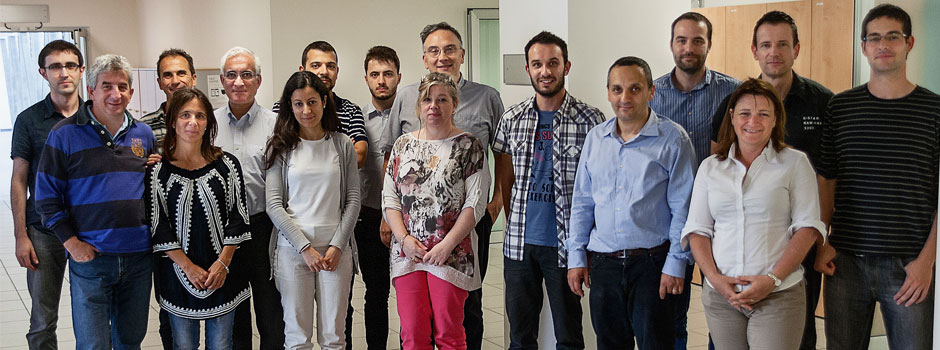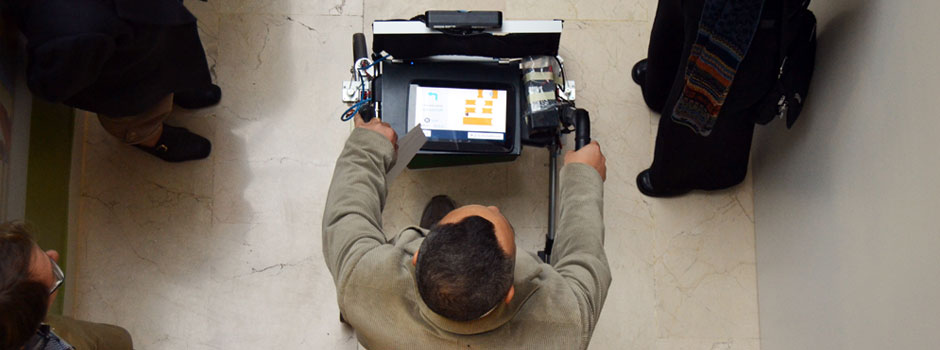 The validation sessions were planned with the main objective of assessing the second prototype designed and developed in the framework of the DALi project. This second prototype includes the navigation functionality which is the main core of the features available in the system, as well as the three possible interfaces thought for the interaction with the users: visual, haptic and auditive. These three possibilities give as the chance to increase the range of final users which can use the cWalker.
The validation sessions were planned with the main objective of assessing the second prototype designed and developed in the framework of the DALi project. This second prototype includes the navigation functionality which is the main core of the features available in the system, as well as the three possible interfaces thought for the interaction with the users: visual, haptic and auditive. These three possibilities give as the chance to increase the range of final users which can use the cWalker.
The validation with final users took place on the days 23, 24 and 25th of September at Indra facilities in Ciudad Real, with the users from the elder residence “Nuestra Señora del Carmen – Ciudad de Matrimonios Ancianos” managed by the area “Dirección General de Mayores, Personas con Discapacidad y Dependientes” of the political branch “Consejería de Sanidad y Asuntos Sociales” from the Castilla la-Mancha región in Spain. These sessions are part of a complete validation plan, that began with lab testing in the University of Trento and that will end with the validation of the additional features with final users in UK.
During these days, the users completed some navigation experiments through a market simulated scenario built for the project’s purpose. These experiments tested the different interfaces and combinations in a navigation problem.

 The validation sessions were planned with the main objective of assessing the second prototype designed and developed in the framework of the DALi project. This second prototype includes the navigation functionality which is the main core of the features available in the system, as well as the three possible interfaces thought for the interaction with the users: visual, haptic and auditive. These three possibilities give as the chance to increase the range of final users which can use the cWalker.
The validation sessions were planned with the main objective of assessing the second prototype designed and developed in the framework of the DALi project. This second prototype includes the navigation functionality which is the main core of the features available in the system, as well as the three possible interfaces thought for the interaction with the users: visual, haptic and auditive. These three possibilities give as the chance to increase the range of final users which can use the cWalker.
 This time in the interview we talk with "Josef Alois Birchbauer " who talks about the research made by Siemens in the Visual Sensing part of the project.
This time in the interview we talk with "Josef Alois Birchbauer " who talks about the research made by Siemens in the Visual Sensing part of the project.
"Navigation can not function without reliable localization. Indoor Positioning is different from outdoors since GPS is not working indoors. We propose a localization system that solely relies on onboard sensors (in particular video sensors) and does not require proprietary installations in the environment like Wi-Fi fingerprinting and Bluetooth..."

 This time we had the opportunity to interview the DALi Project Coordinator "Luigi Palopoli". In this interview, he illustrates the most important results of the project, the underlying
philosophy and the long term research directions triggered by the project activities.
This time we had the opportunity to interview the DALi Project Coordinator "Luigi Palopoli". In this interview, he illustrates the most important results of the project, the underlying
philosophy and the long term research directions triggered by the project activities.
"What we have found is that older adults require an empathic assistance, to identify their need and fight the varied causes that determine their withdrawal from everyday life. Their most important problem is loneliness. Social networks are great to create communities and fight isolation..."

 Now the opportunity was to interview Dr Daniele Fontanelli, a Ph.D. in Automation, Robotics and Bioengineering. Who works in DALi in the design of the mechanical guidance together with the partners from the University of Siena. His research interests include real-time control and estimation, resource aware control, mobile robotics and visual servoing, localization algorithms and human robot interaction.
Now the opportunity was to interview Dr Daniele Fontanelli, a Ph.D. in Automation, Robotics and Bioengineering. Who works in DALi in the design of the mechanical guidance together with the partners from the University of Siena. His research interests include real-time control and estimation, resource aware control, mobile robotics and visual servoing, localization algorithms and human robot interaction.
"The main expected outcome of the DALi project is to deliver an intelligent cart conceived to help senior people in crowded and potentially stressful environments."

 In the past few days, the consortium has its third year plenary meeting in the premises of the DISI department in Trento.
In the past few days, the consortium has its third year plenary meeting in the premises of the DISI department in Trento.
The meeting was started with a demo of the new functionalities implemented in the prototype.
The participant then engaged in an intense discussion on the final experimentation phase, producing a detailed
plan. The next appointments are in Newcastle, where a group of users will be testing the haptic and audio guidance devices, and in Ciuad Real, where users will test the whole prototype.



 Recently we had the opportunity to interview Dr Christopher R Wilkinson; a User Experience Specialist who worked on our DALi project whilst he was a Research Associate in HCI at the University of Trento. In 2014 he was appointed by the European Commission as an Independent Expert Consultant on Human Computer Interaction, Usability, and User Experience.
Recently we had the opportunity to interview Dr Christopher R Wilkinson; a User Experience Specialist who worked on our DALi project whilst he was a Research Associate in HCI at the University of Trento. In 2014 he was appointed by the European Commission as an Independent Expert Consultant on Human Computer Interaction, Usability, and User Experience.
"The involvement of potential users of the device throughout the experimental and design stages ensures we receive design insights that can contribute toward the development of a more usable and user friendly mobility aid for older people"

 During the second review meeting the consortium could show its progress on a series of very impressive demos. In an artificial environment simulating a small marketplace, we could show: long term planning, anomaly detection, reactive planning and guidance with haptic devices.
The demos entailed a deep integration of the work of the different partners and this result was delivered very early on the planned schedule.
During the second review meeting the consortium could show its progress on a series of very impressive demos. In an artificial environment simulating a small marketplace, we could show: long term planning, anomaly detection, reactive planning and guidance with haptic devices.
The demos entailed a deep integration of the work of the different partners and this result was delivered very early on the planned schedule.
The reviewers were positively impressed. The next phase will be experimentation with real people. The Indra facility will be turned into a livign lab, where older adults from a nearby residence will be able to test the functionalities of the system and report their impressions.


 The DALi team has succesfully participated in the Vilnius exhibition.
The DALi team has succesfully participated in the Vilnius exhibition.
At the stand there were people from
Trento, Siemens and Forth to show demos on the cWalker functionalities. In addition a video clips were
continuously streamed to show the work of the rest of the team.
The contact were many and we had lots of interesting discussions with scientists, EC personnel and stakeholders.
We could compare our ideas with those of other people who work in the field of Ambient Assisted Living and
we could fine-tune our work (taking advantage of the experience of other teams) and outline future research directions.


The result measurements of "cWalker experiment" were extremely useful to test, validate and improve the mathematical model we are using in the Cognitive Engine "Social Force Model".
On the "Market experiments" The analysis of the data has been used to develop and tune the localization algorithm for the cWalker.
 “Initial prototyping for off-board image sensors in simulated environment” was the name of the experiment made by Visual Tools in Spain.
“Initial prototyping for off-board image sensors in simulated environment” was the name of the experiment made by Visual Tools in Spain.
The goal of these experiments is to validate the algorithms related to the off-board image-based subsystems that produce data for the long and short-term planners of the Walker.
The data is extracted from videos in scenarios simulating areas of a shopping center and used for generating heat maps, counting people in lines and localization of uniformed people through re-identification.
The steps to reparate the dataset are related to the type of data we are going to produce: Heat Maps // Localization of uniformed people (re-identification) // Counting People in Lines.


The last DALi meeting before the first year review took place at Madrid (Spain) at Indra premises (1st-2nd of October 2012).
Together with this workshop the consortium is accomplishing two activities at Ciudad Real (Spain), a visit to “La ciudad de los Ancianos” and the celebration of three Tea Parties at its facilities.
“La ciudad de los ancianos” is an elderly care residence that follows a pioneer model for its residents. It guarantees that couples that have always lived together continue in that way maintaining a higher privacy and autonomy than in other elderly residences, while offering a lot of group activities.
The residence covers a surface of 10.000 square meters and it has the holding capacity of 112 inmates, 80 with a moderate dependency and 32 with high dependency. The complex in made up of 40 supervised houses and a special unit for highly dependent people.
The Tea Parties involved over 50 members of the general public, both elderly people and care givers, in discussing the benefit of having DALi’s technology and what they would want from such a technology.

In November 17-18, 2011- took place the DALi Kickoff Meeting Trento - Italy.
